In the ever-evolving landscape of electric vehicles, the Kia EV3 and Volvo EX40 emerge as two formidable contenders in the SUV segment. Both models epitomize the latest advancements in automotive technology and sustainability, yet they cater to slightly different tastes and requirements. Here, we delve into a comprehensive comparison of these two electrifying vehicles, highlighting their technical specifications and innovative features.
Kia EV3 vs Volvo EX40 – Which car suits you better?
Two cars, one duel: Kia EV3 meets Volvo EX40.
Which one wins in performance, efficiency and value for money? Find out now!
Design and Dimensions
The Kia EV3 boasts a sleek, modern design, with dimensions measuring 4300 mm in length, 1850 mm in width, and a height of 1560 mm. The interior is roomy, comfortably accommodating five passengers and offering a trunk capacity of 460 liters.
On the other hand, the Volvo EX40 presents a slightly larger presence with its dimensions of 4440 mm in length, 1863 mm in width, and a height of 1647 mm. It also seats five and comes with a trunk capacity of 410 liters. While both vehicles exude a premium feel, the Volvo’s Scandinavian design ethos provides a unique aesthetic appeal.
Performance and Powertrain
When it comes to powertrains, the Kia EV3 offers a choice of two battery capacities: 58.3 kWh and 81.4 kWh, delivering a maximum output of 204 HP (150 kW) and 283 Nm of torque. The EV3 can accelerate from 0 to 100 km/h in 7.5 to 7.9 seconds, depending on the variant, while achieving a top speed of 170 km/h. With an electric range between 436 and 605 km and a consumption of 14.9 to 16.2 kWh/100 km, it stands as a competitively efficient option.
In contrast, the Volvo EX40 takes performance a notch higher with its options ranging from 238 HP (175 kW) to a staggering 408 HP (300 kW). It can accelerate to 100 km/h in as little as 4.8 seconds, with a maximum speed of 180 km/h. The electric range for the EX40 varies between 479 and 576 km, with an energy consumption rate of 16.6 to 17.5 kWh/100 km. Its robust torque, peaking at 670 Nm for certain variants, ensures engaging driving dynamics.
Driving Dynamics and Handling
The Kia EV3 comes equipped with a front-wheel-drive layout that enhances its agility and maneuverability in urban settings. Its lighter curb weight, ranging from 1800 kg to 1885 kg, contributes to improved handling and acceleration performance.
Conversely, the Volvo EX40 offers both rear-wheel and all-wheel-drive configurations. This versatility, combined with a heavier curb weight of 2040 kg to 2170 kg, provides greater stability, particularly under challenging driving conditions. The enhanced torque further amplifies its responsiveness during acceleration.
Innovative Features and Technology
Both the Kia EV3 and Volvo EX40 are packed with the latest technology to enhance the driving experience. The EV3 incorporates advanced infotainment systems, connectivity features, and a suite of driver assistance technologies, underscoring its modern appeal.
The Volvo EX40, leveraging its premium automotive heritage, offers cutting-edge safety features and intuitive technology interfaces. Its advanced driver-assistance systems and in-car connectivity options are tailored for a seamless user experience, ensuring that safety and convenience are top priority.
Conclusion
In summation, both the Kia EV3 and Volvo EX40 stand as remarkable choices in the electric SUV category. The EV3 emphasizes efficiency, practicality, and modern design, making it suitable for everyday drivers seeking a solid electric vehicle. In contrast, the EX40 leans towards performance and advanced technology, appealing to those looking for a more dynamic driving experience.
The decision between these two electric SUVs ultimately depends on individual preferences, driving habits, and desired features. Whether you lean toward Kia's innovation or Volvo's luxurious approach, both vehicles promise a sustainable and exhilarating future on the road.
Here’s where it gets real: The technical differences in detail
Costs and Efficiency:
Looking at overall running costs, both models reveal some interesting differences in everyday economy.
Kia EV3 has a clearly perceptible advantage in terms of price – it starts at 30800 £, while the Volvo EX40 costs 42800 £. That’s a price difference of around 12000 £.
In terms of energy consumption, the advantage goes to the Kia EV3: with 14.90 kWh per 100 km, it’s to a small extent more efficient than the Volvo EX40 with 16.60 kWh. That’s a difference of about 1.70 kWh.
As for range, the Kia EV3 performs hardly perceptible better – achieving up to 605 km, about 29 km more than the Volvo EX40.
Engine and Performance:
Under the bonnet, it becomes clear which model is tuned for sportiness and which one takes the lead when you hit the accelerator.
When it comes to engine power, the Volvo EX40 has a convincingly edge – offering 442 HP compared to 204 HP. That’s roughly 238 HP more horsepower.
In acceleration from 0 to 100 km/h, the Volvo EX40 is clearly quicker – completing the sprint in 4.60 s, while the Kia EV3 takes 7.50 s. That’s about 2.90 s faster.
In terms of top speed, the Volvo EX40 performs minimal better – reaching 180 km/h, while the Kia EV3 tops out at 170 km/h. The difference is around 10 km/h.
There’s also a difference in torque: Volvo EX40 pulls convincingly stronger with 670 Nm compared to 283 Nm. That’s about 387 Nm difference.
Space and Everyday Use:
Beyond pure performance, interior space and usability matter most in daily life. This is where you see which car is more practical and versatile.
Both vehicles offer seating for 5 people.
In curb weight, Kia EV3 is slightly lighter – 1800 kg compared to 2040 kg. The difference is around 240 kg.
In terms of boot space, the Kia EV3 offers to a small extent more room – 460 L compared to 410 L. That’s a difference of about 50 L.
In maximum load capacity, the Volvo EX40 performs somewhat better – up to 1400 L, which is about 149 L more than the Kia EV3.
When it comes to payload, Volvo EX40 hardly perceptible takes the win – 480 kg compared to 470 kg. That’s a difference of about 10 kg.
Who comes out on top?
Overall, the Volvo EX40 shows itself to be leaves the rival little chance and secures the title of DriveDuel Champion.
It convinces with the more balanced overall package and proves to be the more versatile choice for everyday use.
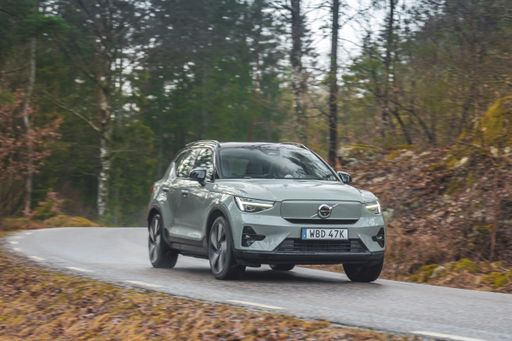 @ Volvo Cars
@ Volvo Cars
Volvo EX40
Kia EV3
The Kia EV3 arrives as a cheeky, practical electric compact that manages to feel both premium and playful, delivering crisp handling and a roomy cabin that's perfect for urban life. With smart tech, friendly styling and sensible pricing, the EV3 is the kind of car that makes switching to electric feel like a no-brainer without asking you to give anything important up.
details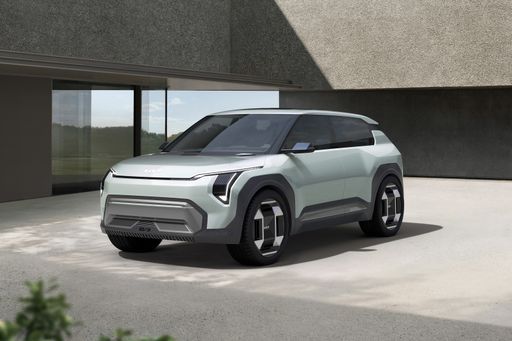 @ Kia Corporation
@ Kia Corporation
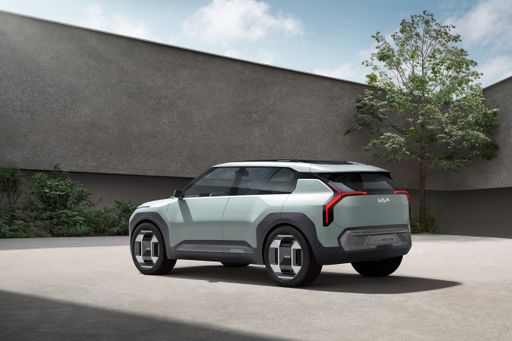 @ Kia Corporation
@ Kia Corporation
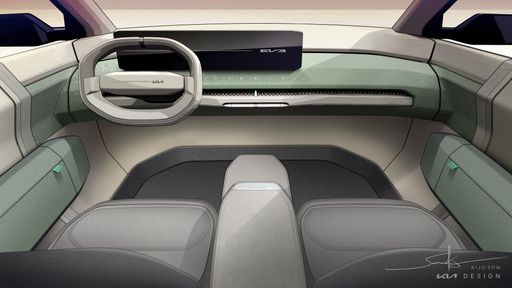 @ Kia Corporation
@ Kia Corporation
Volvo EX40
The Volvo EX40 wraps Scandinavian calm and clever practicality into a compact electric package that feels both premium and refreshingly uncomplicated. It's the grown-up answer to flashier rivals — a safe, comfy, and city-friendly EV with thoughtful tech that makes everyday driving quietly satisfying.
details @ Volvo Cars
@ Volvo Cars
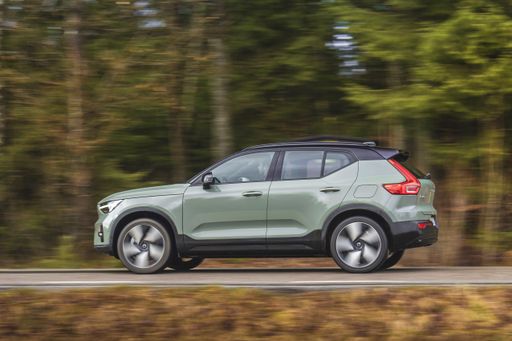 @ Volvo Cars
@ Volvo Cars
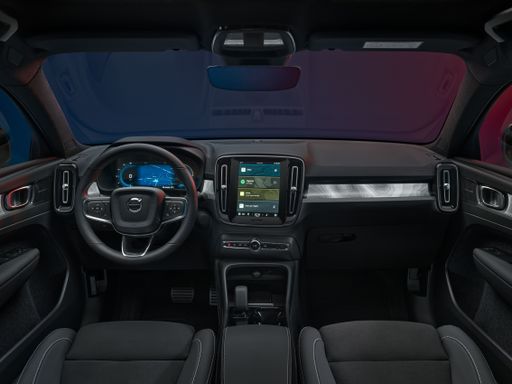 @ Volvo Cars
@ Volvo Cars
 @ Kia Corporation
@ Kia Corporation
|
 @ Volvo Cars
@ Volvo Cars
|
|
|
|
Costs and Consumption |
|
|---|---|
|
Price
30800 - 41700 £
|
Price
42800 - 58200 £
|
|
Consumption L/100km
-
|
Consumption L/100km
-
|
|
Consumption kWh/100km
14.9 - 16.2 kWh
|
Consumption kWh/100km
16.6 - 17.6 kWh
|
|
Electric Range
436 - 605 km
|
Electric Range
480 - 576 km
|
|
Battery Capacity
58.3 - 81.4 kWh
|
Battery Capacity
67 - 79 kWh
|
|
co2
0 g/km
|
co2
0 g/km
|
|
Fuel tank capacity
-
|
Fuel tank capacity
-
|
Dimensions and Body |
|
|---|---|
|
Body Type
SUV
|
Body Type
SUV
|
|
Seats
5
|
Seats
5
|
|
Doors
5
|
Doors
5
|
|
Curb weight
1800 - 1885 kg
|
Curb weight
2040 - 2170 kg
|
|
Trunk capacity
460 L
|
Trunk capacity
410 L
|
|
Length
4300 - 4310 mm
|
Length
4440 mm
|
|
Width
1850 mm
|
Width
1863 mm
|
|
Height
1560 - 1570 mm
|
Height
1647 mm
|
|
Max trunk capacity
1251 L
|
Max trunk capacity
1286 - 1400 L
|
|
Payload
470 kg
|
Payload
430 - 480 kg
|
Engine and Performance |
|
|---|---|
|
Engine Type
Electric
|
Engine Type
Electric
|
|
Transmission
Automatic
|
Transmission
Automatic
|
|
Transmission Detail
Reduction Gearbox
|
Transmission Detail
Reduction Gearbox
|
|
Drive Type
Front-Wheel Drive
|
Drive Type
Rear-Wheel Drive, All-Wheel Drive
|
|
Power HP
204 HP
|
Power HP
238 - 442 HP
|
|
Acceleration 0-100km/h
7.5 - 7.9 s
|
Acceleration 0-100km/h
4.6 - 7.3 s
|
|
Max Speed
170 km/h
|
Max Speed
180 km/h
|
|
Torque
283 Nm
|
Torque
420 - 670 Nm
|
|
Number of Cylinders
-
|
Number of Cylinders
-
|
|
Power kW
150 kW
|
Power kW
175 - 325 kW
|
|
Engine capacity
-
|
Engine capacity
-
|
General |
|
|---|---|
|
Model Year
2024
|
Model Year
2024
|
|
CO2 Efficiency Class
A
|
CO2 Efficiency Class
A
|
|
Brand
Kia
|
Brand
Volvo
|
What drive types are available for the Kia EV3?
The Kia EV3 is offered with Front-Wheel Drive.
The prices and data displayed are estimates based on German list prices and may vary by country. This information is not legally binding.
